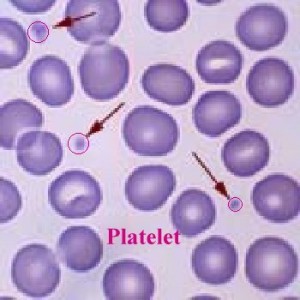Platelets, red cells, and plasma are the major components that form the human blood. Platelets are irregular shaped molecules with a colorless body and sticky surface that forms into clots to help stop the bleeding. When a person’s normal platelet count is compromised that person’s life might be put in danger.
Platelets are fragments of cells that break off from the bone marrow. Calcium, protein, and vitamin k are minerals that help platelets create clots. When blood is exposed to air, clots are formed to stop the bleeding and when either one of these minerals are lacking it could put a person’s life at risk.
Platelet Count
A platelet count is part of a complete blood count test. It is ordered when a patient experiences unexplainable bruises or when small cuts and wounds take longer time to heal. A normal platelet count of an average person is 150,000 to 450,000 platelets per microliter of blood. Others may have abnormal platelet count but it doesn’t indicate any abnormality.
Determining the number of platelets is counted through three different ways, they are:
• Hemacytometer Counting
Hemacytometer is an instrument that has a grid etched on its surface that guides physicians during counting of the cells. A diluted blood sample would be placed in the hemacytometer and through a microscope they can view the blood.
• Electronic Counting: Voltage Pulse and Electro Optical Counting
This is the most common method and is composed of two different types, namely, the voltage pulse and the electro optical counting system. Both of these systems collect blood that is diluted and placed into an electronic counter for counting. Using these methods is not 100% accurate as many variables can affect the results. There are some instances when other platelets are not recognized or when a patient has high white blood cell count the machine might interpret it automatically with a low platelet count.
Low Platelet Count
When platelet count falls below 20,000 per microliter, this situation is considered as life threatening in which extensive bleeding might likely occur. There are several causes why a person’s normal platelet count decreases, they are:
• Decrease in platelet production
• Increase in the platelet destruction
• Increase in splenic sequestration
Some of the disorders that lead to decrease in platelet count are:
• Thrombocytopenia
o Idiopathic thrombocytopenia purpura
o Drug induced thrombocytopenia purpura
o Thrombotic thrombocytopenia purpura
• Aplastic anemia
• Gaucher’s disease
• Onyalai
• Fetomaternal alloimmune thrombocytopenia
• HELLP syndrome
• Chemotherapy
• Dengue
• Hemolytic-uremic syndrome
Symptoms of a person with low platelet count are:
• Bleeding such as nosebleed, rectal bleeding, gastrointestinal bleeding, bleeding gums, and bleeding skin rash
• Bleeds easily
• Petechiae (red dots caused by bleeding underneath the skin)
• Bruises
• Blood in stool and urine
• Heavy menstrual period
• Tiredness
• Feeling of uncertainty
High Platelet Count
A higher than normal platelet count can cause serious health problems. Too much clotting in the blood might cause blockage and may sometimes lead to stroke. High platelet count can be determined through routine blood count tests.
High platelet count is divided into two sub categories namely, the primary thrombocythemia and the secondary thrombocythemia. Cause of high platelet under primary thrombocythemia is still not known but is believed to occur as an independent condition. While on secondary thrombocythemia, it causes normal platelet count to increase as a symptom of various diseases. These conditions or diseases are as follows:
• Anemia
• Cancer
• Blood loss
• Chemotherapy
• Infection
• Chronic myelogenous leukemia
• Kawasaki disease – a rare disease that causes inflammation in the blood vessels
• Myelodysplasia – is a group of conditions that causes blood cells to develop and function abnormally
• Polycythemia vera – a rare disorder in the bone marrow that causes over production of blood vessels
• Splenectomy – removal of the spleen surgically
• Medications such as steroid
Symptoms that may occur when a person has high platelet count are:
• Bleeding
• Numbness of hands and feet
• Headache
• Weakness
• Bleeding in the mouth and gums
• Stools with blood
• Easily bruised
• Nosebleeds
• Difficulty in breathing
• Changes in speech
• Confusion
• Frequent loss of consciousness for a brief period of time
• Dizziness
• Nausea
• Throbbing pain in the arms and legs
• Seizures
Treatments and Medications
Platelets are natural healing agents that help the body heal itself. Oral and intravenous agents may be used to suppress platelet functions. Other than that, there is still no known treatment besides blood transfusion to obtain a normal platelet count. A natural remedy that may help a person regain his or her normal platelet level is through eating a healthy, well balanced diet or practicing some stress relieving techniques. Stress can lead to so many diseases and conditions that can also be life threatening. Getting rid of these stress factors is the key to living a long, happy and healthy life.
